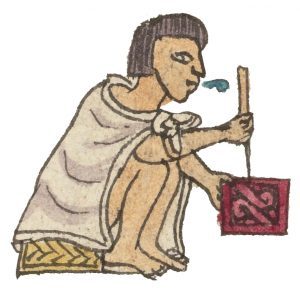Yesterday, a team of specialists of the National Institute of Anthropology and History of Mexico, led by the historians Baltazar Brito Guadarrama and María Castañeda de la Paz, the philologist Michel Oudijk, and the Nahuatl specialist Rafael Tena, presented to the public the discovery of three new Aztec codices, collectively known as the Codices of San Andrés Tetepilco, formerly a part of the Culhuacan polity of Central Mexico, and nowadays located within the Iztapalapa borough in Mexico City. This is one of the most exciting and spectacular discoveries regarding codical sources in recent years, and is no doubt closely related to the topic of this blog. The discovery has been already covered by the Mexican press and explained in detail in yesterday’s presentation at the National Museum of Anthropology in Mexico City, which can be seen in Youtube. However, an English summary will be presented for the readers of this blog.
The newly discovered corpus was acquired by the Mexican government from a local family that wants to remain anonymous, but which were not collectors but rather traditional stewards of the cultural legacy of Culhuacan and Iztapalapa, and it is now stored at the library of the National Institute of Anthropology and History of Mexico. It comprises three codices. The first is called Map of the Founding of Tetepilco, and is a pictographic map which contains information regarding the foundation of San Andrés Tetepilco, as well as lists of toponyms to be found within Culhuacan, Tetepilco, Tepanohuayan, Cohuatlinchan, Xaltocan and Azcapotzalco. The second, the Inventory of the Church of San Andrés Tetepilco, is unique, as Oudijk remarks, since it is a pictographic inventory of the church of San Andrés Tetepilco, comprising two pages. Sadly, it is very damaged.
Finally, the third document, now baptised as the Tira of San Andrés Tetepilco, is a pictographic history in the vein of the Boturini and the Aubin codices, comprising historical information regarding the Tenochtitlan polity from its foundation to the year 1603. It seems to belong to the same family as the Boturini, the Aubin, the Ms. 40 and the Ms. 85 of Paris, that is to say, some of the main codices dealing with Aztec imperial history, and Brito considers it as a sort of bridge between the Boturini and the Aubin, since its pictographic style is considerably close to the early colonial one of the former, rather than the late colonial one of the latter. It comprises 20 rectangular pages of amate paper, and contains new and striking iconography, including a spectacular depiction of Hernán Cortés as a Roman soldier. In the Aztec side of things, new iconography of Moctezuma Ilhuicamina during his conquest of Tetepilco is presented (Figure 1).

Of course, new and very interesting examples of Aztec writing are contained throughout all these documents, including old and new toponyms, spellings of Western and Aztec names, and even some information that confirms that some glyphs formerly considered as hapax, as the chi syllabogram in the spelling of the name Motelchiuhtzin in Codex Telleriano-Remensis 43r, discussed in another post of this blog, were not anomalous but possibly conventional. Besides logosyllabic spellings, the presence of pictographs with alphabetic glosses in Nahuatl will be of great help to ascertain the functioning of this still controversial part of the Aztec communication system.
In any case, the author of this blog remains expectant of the future digital and physical publication of the Codices by Baltazar Brito’s team of experts, promised yesterday, and congratulate them for their breakthrough discovery. Cheers for Aztec writing and its everlasting cultural legacy!


Amazing!
LikeLike
[…] Article URL: https://tlacuilolli.com/2024/03/21/new-aztec-codices-the-codices-of-san-andres-tetepilco/ […]
LikeLike
[…] 详情参考 […]
LikeLike
[…] Keep reading […]
LikeLike
[…] 2. New Aztec codices discovered on amate paper. […]
LikeLike
[…] New Aztec Codices Discovered: The Codices of San Andrés Tetepilco 370 by dzdt | 150 comments . […]
LikeLike
[…] New Aztec Codices Discovered: The Codices of San Andrés Tetepilco 370 by dzdt | 150 comments on Hacker News. […]
LikeLike